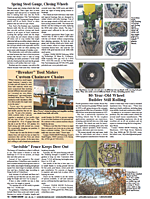You have reached your limit of 3 free stories. A story preview is shown instead.
To view more stories
(If your subscription is current,
click here to Login or Register.)
Intensive Gardening Produces More With Less
If attempting to maximize garden production within minimal space, consider taking a lesson from Paris. French intensive gardening is a permaculture system based on raised beds, tight spacing, and succession planting that aims to get the most from every inch. The goal is high yields, often four to six times greater prod
..........
You must sign in, subscribe or renew to see the page.

You must sign in, subscribe or renew to see the flip-book
Intensive Gardening Produces More With Less
If attempting to maximize garden production within minimal space, consider taking a lesson from Paris. French intensive gardening is a permaculture system based on raised beds, tight spacing, and succession planting that aims to get the most from every inch. The goal is high yields, often four to six times greater productivity than expected for the space.
French intensive gardening relies on a series of permanent raised beds, preferably oriented north to south to maximize light exposure. These beds typically sit below ground level and are created by single or double-digging the soil to a depth of about 15 in. This process forms a loose bed with a slight mound, which enhances aeration.
The ideal height above soil level varies by climate. In warm regions, beds only need to be raised an inch or two, while in colder climates, 8-in. high beds help capture more sunlight and improve drainage. In dry areas, sunken beds may be better suited to conserve moisture.
Ideally, the beds only need to be dug once. Over time, worms and cover crops help maintain soil looseness. Most beds are kept 3 to 4 feet wide, with permanent pathways around them to ensure the beds are never stepped on. This minimizes soil compaction and concentrates nutrients where plants need them most.
French intensive beds thrive with tight spacing—often two to five times closer than in traditional vegetable gardening. This works because the loose soil allows roots to grow downward, improving nutrient access. The goal is to minimize bare soil, which helps prevent weed growth. Light mulching can further suppress weeds as slow-growing plants mature.
However, this high concentration of plant life requires significant fertilization. Compost and manure are commonly used. Crop rotation is also important, especially for nitrogen-hungry plants like tomatoes, as it helps prevent disease. Overall, weed and disease issues should be minimal when the system is managed properly.
The tight spacing allows experimentation with many growing styles, including companion planting. Consider matching short and long roots, fast and slow growers, short and tall, etc. One popular strategy is planting radishes around perimeters for a quick harvest. Likewise, some gardeners focus on compact and dwarf varieties.
French intensive gardening requires plenty of elbow work up front, but it’ll reward you with abundant, consistent harvests over the long term. If you’re short on space, it’s a garden plan well worth attempting.
To read the rest of this story, download this issue below or click
here to register with your account number.





